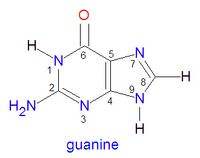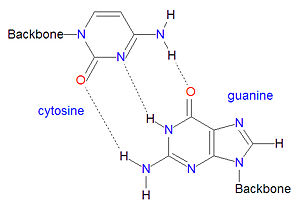Guanine: Difference between revisions
Jump to navigation
Jump to search

Pat Palmer (talk | contribs) (adding HMDB ref) |
Pat Palmer (talk | contribs) mNo edit summary |
||
| Line 22: | Line 22: | ||
Guanine and [[cytosine]] form a very stable Watson-Crick [[base pair]] containing three [[hydrogen bond]]s. | Guanine and [[cytosine]] form a very stable Watson-Crick [[base pair]] containing three [[hydrogen bond]]s. | ||
== Footnotes == | |||
<references> | |||
</references> | |||
Revision as of 07:54, 13 July 2024
|
| |||||||
| guanine | |||||||
| |||||||
| Uses: | |||||||
| Properties: | DNA/RNA base | ||||||
| Hazards: | |||||||
| |||||||
Guanine[1] is a natural biomolecule used as one of the five bases in RNA and DNA. It is incorporated into these nucleic acids in the form of guanosine, a chemical compound formed by the combination of guanine and a ribose sugar. Guanine is also naturally present in phosphorylated forms of guanosine.
Basepairs
Guanine and cytosine form a very stable Watson-Crick base pair containing three hydrogen bonds.
Footnotes
- ↑ Guanine (HMDB0000132) in the Human Metabolome Database (HMDB).

